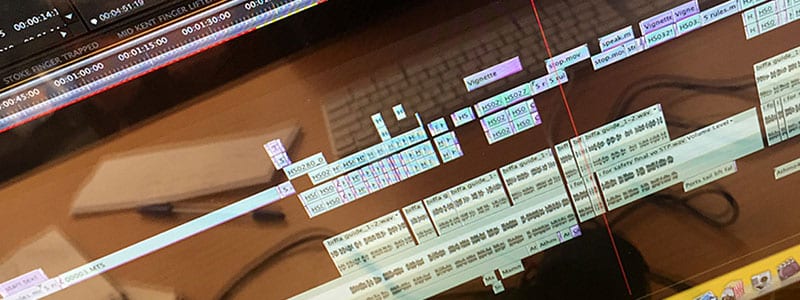Cut to the Chase
Many briefs in corporate video and professional video editing require the cutting down of long interviews to find the essential soundbites and answers. Hardly a project goes by when we are not faced with taking 10, 20 or even 30 minute interviews and finding the right selection of 10 second quotes to efficiently convey the message we want.
In some cases we can simply send a timecoded transcript to our client and they can select the best lines, but this is sometimes misleading as what may look like the best line on paper may lack conviction and credibility when delivered to camera. This is something that can’t be communicated when simply reading words on a page.
So sometimes the role of professional video editing is to trawl through the interview content and make the call on the best final soundbites themselves. But doing this can be time consuming and complex. So here’s our approach to cutting interviews down.
First Cut
Firstly, create a sequence/timeline and chuck every frame of the video on it. This is our starting point. Now this example assumes that only this interviewee will be used in the video and that the interviewers questions will be cut out. This is generally the case as we don’t wont to waste viewers time when watching the film having to listen to the questions being read. Hopefully the answers are delivered in statement fashion and can stand alone in conveying the message as opposed to simply being a yes/no answer.
So the first task is to edit out and remove form the timeline all the interviewer’s questions, pauses in the interview recording, and false starts/outtakes etc. A quick way to do this is to use the audio waveform as an indication of when the subject is talking and simply trim everything else.
So now we have a timeline containing just the stuff we want to choose from for our corporate video.
Powerful Comments
Next up, copy this sequence and rename it as ‘Interviews 2nd cut’ or something along these lines. We’re now going to watch this timeline through and remove any answers that feel too long, off topic, or generally not ones that feel powerful. As we’re doing this we keep the film’s message in mind and will usually label ‘killer quotes’ on the timeline so that we can easily navigate back to them later.
Once we’ve been through this second cut we should be left with our shortlist of useable comments.
Now we repeat the process by copying the sequence again and re-naming it as ‘Interviews 3rd cut’ or similar. This is useful in case the client comes back to you once they’ve viewed the draft edit and requests a comment about a topic not in the draft you sent. To quickly scan a sequence and say “yes, we’ve got it” rather than trawling through all the footage again saves time and it’s a very common request.
So now you should have ‘Interviews 3rd cut’ and this is really where you’ll find your narrative and identify the strongest quotes. A key part of professional video editing is not being afraid to be ruthless. You may still have 10 minutes of great comments and a target duration of only two minutes, so go with your gut and if you’ve any doubts about a particular quote, delete it from the timeline. You can now also play around with chronology and try a few comments back to back or in different orders to see what flows well and works best.
Be Ruthless
If you’re cutting B-roll over the top of these interviews (and lets face it, we hope so as 2 minutes of a talking head isn’t going to light anyone up!) you’ll have some flexibility to cut into the actual quotes and answers. This is great for removing “ums” and “errs” from video marketing films that don’t sell what they’re saying, but can also be useful if you’ve got two takes of one question and you like the start of one and the end of the other. As mentioned, being ruthless here is the key, and if you are then you’ll find this third cut starting to feel like a powerful corporate video with a strong message.
If you’re not using B-roll but need to cut a portion of one answer there is another option open to you. You can scale down the timeline to allow you to create a two-camera look. This is only possible if you know that your client will accept a 720p delivery and you’ve shot at 1080p, or a 1080p delivery and you’ve shot at 4K. By downscaling the size of the frame you can use the footage at 100% scale as a ‘punch in’ and then scale the footage down to match the dimensions of the frame for a mid shot. Even though it’s the same shot and we’re essentially just zooming in on it, it’s a cut that audiences will tolerate and won’t look odd. It’s a useful professional video editing trick and one that we use often.
So that’s about all there is to it. The keys are to keep the first and second cut timelines to allow you to quickly respond to amendment requests, and secondly to be ruthless with your cutting. As mentioned, going with your gut is almost always the best way to choose the right quotes as you’re acting on emotional instinct and will be drawn to the quotes that connect with you on an emotional level. As we know these are the type of quotes that always form the most engaging viewing.
To find out more about us and our services, please click here.


